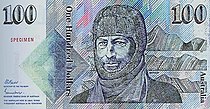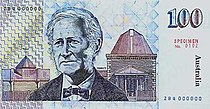Australian_one-hundred-dollar_note
Australian one-hundred-dollar note
Current denomination of Australian currency
The Australian one-hundred-dollar note was first issued in 1984 as a paper note.[2] There have been two different issues of this denomination: initially a very light turquoise-blue paper note, and from May 1996, a green polymer note.[3] Since the start of issue there have been six signature combinations. Two other combinations were not issued.[citation needed]
| (Australia) | |
|---|---|
| Value | 100 Australian dollars |
| Width | 158 mm |
| Height | 65 mm |
| Security features | Clear window with embossing, micro printing, slightly raised printing, hold the note towards light and the Australian coat of arms plus a seven pointed star will appear, ultraviolet, Unic serial number and different fonts, watermark |
| Material used | Polymer |
| Years of printing | 1996, 1998–99, 2008, 2010–11, 2013–14, 2017, 2019-20 [1] |
| Obverse | |
| Design | Dame Nellie Melba |
| Designer | emerystudios |
| Design date | 29 October 2020 |
| Reverse | |
| Design | General Sir John Monash |
| Designer | emerystudios |
| Design date | 29 October 2020 |
The paper issue was released on Monday 31 March 1984, has a portrait of Antarctic explorer Sir Douglas Mawson, with a background of a mountain range with a geological strata format. A large diamond shape appears to the left of the main picture. Astronomer John Tebbutt is on the reverse, with a background of the observatory he built and a local church.[4]
| The original paper 100-dollar note. | |
 |
 |
The polymer issue was released on Wednesday 15 May 1996, designed by Bruce Stewart, and features portraits of soprano Dame Nellie Melba and engineer and First World War general Sir John Monash, along with images from the First World War and John Simpson Kirkpatrick and his donkey. .[3][5]
| The original polymer 100-dollar note. | |
A new design of the banknote, part of the Reserve Bank's Next Generation Banknote Program, was released into circulation on Thursday 29 October 2020.[6]
The paper design includes a watermark of Captain James Cook in the white field, and a metallic strip embedded in the paper to the left (on the obverse side) of the note. The same watermark was used in the last issue of the pre-decimal banknotes.[citation needed]
The polymer issue includes a shadow image of the Australian Coat of Arms, which is printed over. In the clear window, there is embossing—or a raised image—of the number 100 and a print of a lyrebird. Also for this issue, fluorescent colouring was added to the serial numbers, as well as a patch that shows the banknote's value under ultraviolet light. The star's four points on the obverse and three on the reverse join to form the seven-pointed Federation Star when the note is held up to the light. Raised print and micro-printing of the denomination value are also included.[7][8]
According to Reserve Bank of Australia statistics, the number of $100 banknotes in circulation in June 2005 was 149 million—18.5% of all notes in circulation. The cash value for these notes was $14,924 million—41.9% of the total value for all denominations. Only the $50 note had more cash value in circulation.[9] In June 2008 there were 176.9 million notes in circulation (19%), with a value of $17,690 million (42.1%).
In June 2017, 337 million $100 notes were in circulation,[10] 22% of the total notes in circulation; worth $33,689 million, 46% of the total value for all denominations.[11]
In December 2016 it was reported that Australia considered abolishing its $100 note as an effort to close loopholes used by the black economy.[10] However, the Reserve Bank of Australia officially stated that there are no plans to abolish the $100 note.[12]
- "SERIAL NUMBER INFORMATION". banknotes.rba.gov.au. Reserve Bank of Australia (RBA). Retrieved 9 February 2015.
- "OTHER BANKNOTES-PAPER SERIES-$100". banknotes.rba.gov.au. Reserve Bank of Australia. Retrieved 9 February 2015.
- "A Complete Series of Polymer Banknotes: 1992–1996". Reserve Bank of Australia Museum. Reserve Bank of Australia. Archived from the original on 15 February 2016. Retrieved 31 December 2015.
- "Inflation and the Note Issue". Reserve Bank of Australia Museum. Reserve Bank of Australia. Archived from the original on 27 April 2016. Retrieved 31 December 2015.
- "Defence Honours and Awards Appeals Tribunal" (PDF). Australian Government. Retrieved 26 June 2023.
- "Next Generation of Banknotes: $100 Design Reveal" (Press release). Sydney, Australia: Reserve Bank of Australia. 24 February 2020. Retrieved 25 February 2020.
- "List of Security Features". Counterfeit Detection. Reserve Bank of Australia. Retrieved 9 February 2015.
- "Banknote Features". Reserve Bank of Australia Banknotes. Retrieved 26 June 2023.
- Notes on Issue, www.rba.gov.au, Data updated to end June 2008, Reserve Bank of Australia. Retrieved on 4 August 2015.
- Frank Chung. "Australia could scrap the $100 note". The New Zealand Herald. Retrieved 14 December 2016.
- "DISTRIBUTION-CIRCULATION AND PRODUCTION STATISTICS, AS AT END JUNE 2017". banknotes.rba.gov.au. Reserve Bank of Australia. Retrieved 20 December 2017.
- Ian W. Pitt, ed. (2000). Renniks Australian Coin and Banknote Values (19th ed.). Chippendale, NSW: Renniks Publications. pp. 171–172. ISBN 0-9585574-4-6.